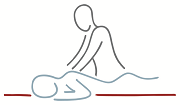Many people have scars that cause them no problems at all. However, there are a number of common complaints that I hear from clients who do have issues.
When we have surgery or a deep, accidental wound many layers of the body’s structure will be damaged. This includes our nerves. When a scar forms, nerves will still be disrupted or trapped and strange feelings can occur in the area. This disruption is generally felt in three completely different ways:
Complete numbness, no feeling at all.
Desensitisation, where you know you are touching the skin, but it doesn’t quite feel like yourself.
Hypersensitivity, where your awareness is constantly drawn to the area even if the slightest thing brushes against it.
You may even have areas of both hypersensitivity and desensitisation on the same scar!
The good news is that these feelings are rarely permanent. And interacting with the area will help stimulate the nerves and speed up the recovery process. Applying moisturiser, gently stroking around the scar and specialist Scarwork™ therapy can all help to encourage the nerves to repair themselves and restore a more normal feeling.
Here is a bit more detail about common issues:
Pain, itchiness, tingling, numbness – These are all usually caused by damage to the nerves in the area around the scar. Either the nerves were cut during the accident or surgery and now have no pathway for the message to travel along or the nerves are locked up in the scar tissue. The body will be trying to re-join the pathways and still send message along the damaged ones so weird sensations are common. Softening the scar tissue and promoting healing with Scarwork™ can often help to decrease the pain and itchiness. Sometimes, however, it can stimulate tingling in numb areas as the body starts to heal again. This should subside as healing continues.
Lumps, bumps and dips – Accident scarring often heals less neatly than surgical. Stiches can help keep the surface scar neat. Under the surface, however, is a different matter. Different tissues will heal at different rates, some layers may stick together and if tissue is missing (or removed in surgery) then the resulting scar will be pitted and uneven. As scar tissue matures, over about 2 years, it will naturally shrink and pull the sides of the original wound together. This can cause puckering and restrict the movements in that area. Scarwork™ and Soft Tissue Therapy can combine to soften the scar, even out the lumps and improve restricted movement.
Pain and tightness in other areas of the body – Under our skin, there is a layer of connective tissue called Fascia. This tissue wraps around all of our muscles and organs. It keeps them separate but working together. When we are cut, this layer is cut too and scars in the same way as all the other layers. Think of it like a darn in your sock. The stretchiness of the sock is compromised, it does not look, feel or act in the same way as before. This is the same as in our bodies. Because an area is scarred, it does not perform the same and other areas of the body have to work harder to compensate. Through the fascial web, this compensation pattern can affect all parts of the body, although, commonly the areas affected are closely connected to the scarred area.
Common examples of problems caused by scarring are:
Back ache after a c-section
Hip pain after Appendectomy
Shoulder problems after Mastectomy
Hip issues after Broken Ankle
Breathing difficulty after Gall Bladder Removal (close to Diaphragm)
Sometimes the pain may appear years after the surgery or accident as the compensation pattern takes a long time to cause a problem in the new area. This is why I will always discuss old surgeries and scars with you as part of my assessment for Soft Tissue Therapy. If you have any questions, please get in touch.

